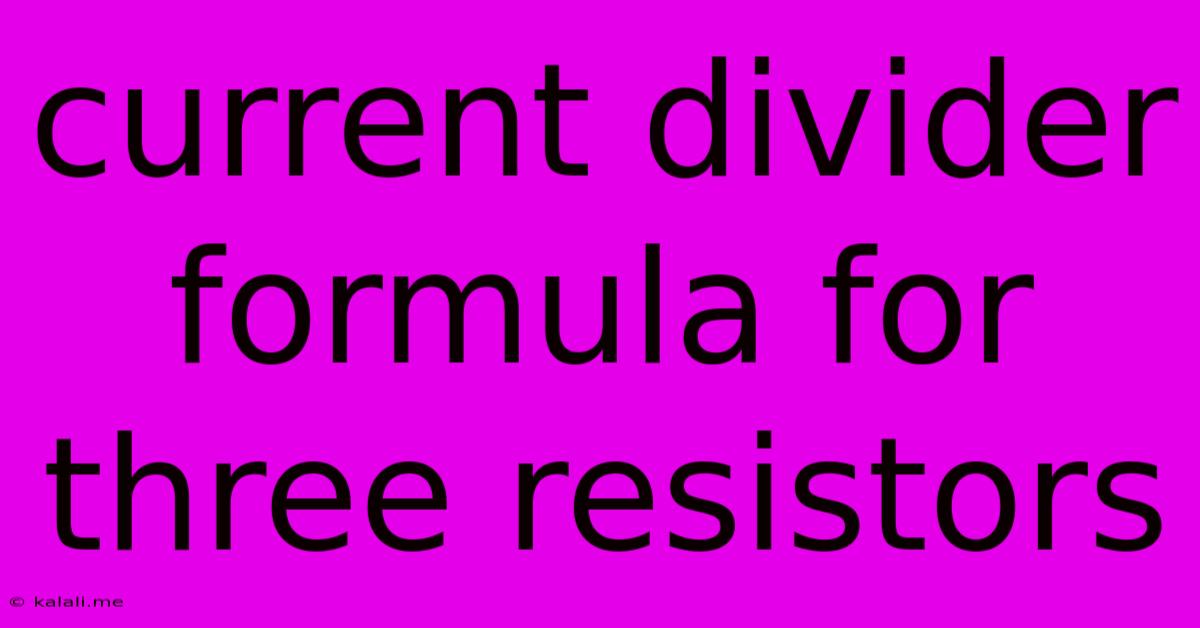Current Divider Formula For Three Resistors
Kalali
Jun 06, 2025 · 3 min read

Table of Contents
Understanding the Current Divider Formula for Three Resistors
The current divider rule is a fundamental concept in electrical engineering used to determine the current flowing through individual branches of a parallel circuit. While the formula for two resistors is straightforward, calculating the current division among three or more resistors requires a slightly more nuanced approach. This article will delve into the current divider formula for three resistors, explaining the concept and providing practical examples. This will help you understand current division in more complex circuits.
What is a Current Divider?
A current divider is a parallel circuit configuration where the total current splits among multiple branches, each containing a resistor (or other impedance). The amount of current flowing through each branch is inversely proportional to the resistance of that branch. This means that a smaller resistor will carry more current than a larger resistor in a parallel circuit.
Deriving the Formula for Three Resistors
Let's consider a parallel circuit with three resistors: R1, R2, and R3, and a total current (IT) entering the parallel combination. Using Ohm's law (V = IR) and Kirchhoff's current law (the sum of currents entering a node equals the sum of currents leaving), we can derive the formula for each branch current:
-
The voltage across each resistor is the same and equal to the total voltage (VT) across the parallel combination. This is a crucial aspect of parallel circuits.
-
The current through each resistor (I1, I2, I3) can be calculated using Ohm's Law:
- I1 = VT / R1
- I2 = VT / R2
- I3 = VT / R3
-
The total current (IT) is the sum of the individual branch currents:
- IT = I1 + I2 + I3
-
The total conductance (GT) is the sum of individual conductances: GT = 1/R1 + 1/R2 + 1/R3. Conductance (G) is the reciprocal of resistance (G = 1/R).
-
The total resistance (RT) is the reciprocal of the total conductance: RT = 1/GT
-
Therefore, we can express each branch current in terms of the total current and resistances:
- I1 = (R2 || R3 / (R1 + (R2 || R3)) * IT
- I2 = (R1 || R3 / (R2 + (R1 || R3)) * IT
- I3 = (R1 || R2 / (R3 + (R1 || R2)) * IT
Where '||' denotes the parallel combination of resistors. For example, R2 || R3 = (R2 * R3) / (R2 + R3)
Simplified Formula for Equal Resistors
If all three resistors are equal (R1 = R2 = R3 = R), the formula simplifies significantly:
- I1 = I2 = I3 = IT / 3
Practical Example
Let's say we have a parallel circuit with R1 = 10 ohms, R2 = 20 ohms, and R3 = 30 ohms. The total current entering the parallel combination is 1 Ampere (IT = 1A). To find the current through each resistor, we first calculate the equivalent resistance of the parallel combination:
1/RT = 1/10 + 1/20 + 1/30 => RT ≈ 5.45 ohms
Then we use the formulas derived above:
- I1 ≈ 0.545 A
- I2 ≈ 0.273 A
- I3 ≈ 0.182 A
Notice that the sum of these currents equals the total current (1A), validating our calculations.
Conclusion
Understanding the current divider rule for three resistors, and more generally for multiple resistors, is crucial for analyzing and designing complex circuits. While the formulas might seem intricate at first glance, they are based on fundamental principles of Ohm's and Kirchhoff's laws. By mastering this concept, you will significantly enhance your circuit analysis skills and be able to handle more advanced electrical engineering problems. Remember that careful attention to detail in calculations is key to obtaining accurate results.
Latest Posts
Latest Posts
-
Term For Performing A Search And Getting Suggestions With Mispellings
Jun 07, 2025
-
How Do You Say For In Chinese
Jun 07, 2025
-
Is It Better To Remove Crabgrass Area And Reseed Lawn
Jun 07, 2025
-
Can You See Messages On Icloud
Jun 07, 2025
-
Tree Of Life Vs Tree Of Knowledge
Jun 07, 2025
Related Post
Thank you for visiting our website which covers about Current Divider Formula For Three Resistors . We hope the information provided has been useful to you. Feel free to contact us if you have any questions or need further assistance. See you next time and don't miss to bookmark.